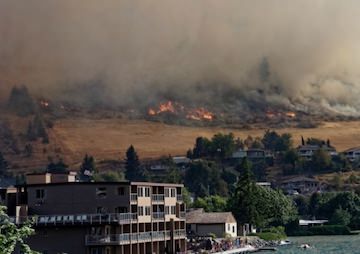Wilder Fires and Rising Waters: Climate Impacts Are Approaching America’s Door
A pair of new studies shows how American climate refugees will "reshape" the population landscape of the nation. The Chelan Butte fire of 2015 encroaches on homes in coastal Washington state. (Ben Brooks / Flickr)(CC-BY)
The Chelan Butte fire of 2015 encroaches on homes in coastal Washington state. (Ben Brooks / Flickr)(CC-BY)
By Lauren McCauley / Common Dreams
Americans in many cases have been slow to acknowledge the real threats posed by global warming. But two new studies out Monday found that people living throughout the United States could soon see their communities forever altered by higher seas and raging forest fires.
While the United States has lagged in taking dramatic action to reduce greenhouse gas emissions or transform its power grid to accommodate renewable energy sources, other nations have taken the lead. Further, studies have historically shown (pdf) that Americans are generally reluctant to perceive climate change as anything more than a moderate risk, seeing it as something that impacts people in more vulnerable, developing nations.
The idea of a person becoming a climate change refugee seems similarly foreign.
However, Mathew Hauer, a demographer at the University of Georgia, estimates that by the end of the century as many as 13.1 million Americans could too find themselves displaced due to rising sea levels. His research is published in the journal Nature Climate Change and suggests those migrants will be forced to move to inland cities, ultimately “reshaping” the population landscape.
The report notes that unmitigated sea-level rise (SLR)—primarily seen as “a coastal issue”—is “expected to reshape the U.S. population distribution, potentially stressing landlocked areas unprepared to accommodate this wave of coastal migrants.” For instance, if seas rise the expected 1.8 meters by 2100, Texas could see a surge of nearly 1.5 million additional residents. Specifically, inland cities including Austin and Houston, Texas; Orlando, Florida; and Atlanta, Georgia could each see more than 250,000 people migrating from the imperiled coasts.
Meanwhile, Miami and New Orleans are expected to lose more than 2 million people each due to flooding, while nine states could experience declining populations: Virginia, South Carolina, Massachusetts, Georgia, North Carolina, New Jersey, Louisiana, California, and New York.
At the same time, residents who live near the sun-scorched valleys and drought-wracked forests of the western U.S. are going to increasingly see larger, more devastating forest fires—and researchers are beginning to recognize that the only way to deal with them is to get out of the way.
A study published at the Proceedings of the National Academy of Sciences says that typical methods of wildfire suppression and management are inadequate to address the threat posed by the “new era of western wildfires” prompted by human-induced global warming.
“Neither suppression nor current approaches to fuels management adequately reduce vulnerability of communities to increasing wildfire,” said the study’s lead author, Tania Schoennagel, a research scientist at the University of Colorado-Boulder’s Institute of Arctic and Alpine Research. “We’ve been very effective with fire suppression for many years, but wildfires are increasing beyond our capacity to control, especially with more people in fire’s way.”
Alternately, the report recommends that affected states take steps to adapt by discouraging development in wildfire-prone areas and, in some cases, letting the fires rage with controlled burns.
InsideClimate News reported further on the study:
The report notes that a century of suppressing wildfires in the West has created a tinderbox because trees aren’t being removed naturally by fire.
“Most people recognize that our forest systems have not had the fire they need,” Schoennagel said […]
The concept of allowing fires to burn is controversial, in part because of the risk it poses to people and structures, but also because of the carbon released into the atmosphere. Schoennagel argues, though, that prescribed burns ultimately could help ecosystems and species adapt to warming.
“Fire can be used as a tool for ecosystems to adapt to a changing climate,” she explained. “It can allow species to migrate and help species keep pace with climate change.”
Park Williams, a bioclimatologist the Lamont-Doherty Earth Observatory at Columbia University who was unaffiliated with the study, told Climate Central, “We now know that continued increases in fire activity are inevitable, but we’ve been able to come up with no other way forward other than to fight fires as hard as we can. All we’re doing is paying huge amounts of money to deliver an even worse problem onto the next generation.”
And Schoennagel added, “The first step is to expect that wildfire will come to your door rather than assume it will not.”
One could say the same for the seas.
Your support matters…Independent journalism is under threat and overshadowed by heavily funded mainstream media.
You can help level the playing field. Become a member.
Your tax-deductible contribution keeps us digging beneath the headlines to give you thought-provoking, investigative reporting and analysis that unearths what's really happening- without compromise.
Give today to support our courageous, independent journalists.








You need to be a supporter to comment.
There are currently no responses to this article.
Be the first to respond.